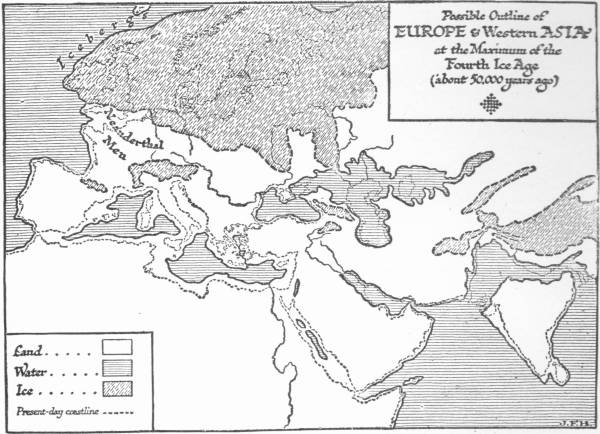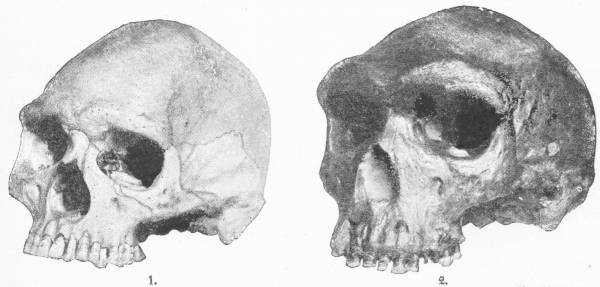




THE NEANDERTHALER, ACCORDING TO PROF. RUTOT
At that time the climate and geography of our world was very different from what they are at the present time. Europe for example was covered with ice reaching as far south as the Thames and into Central Germany and Russia; there was no Channel separating Britain from France; the Mediterranean and the Red Sea were great valleys, with perhaps a chain of lakes in their deeper portions, and a great inland sea spread from the present Black Sea across South Russia and far into Central Asia. Spain and all of Europe not actually under ice consisted of bleak uplands under a harder climate than that of Labrador, and it was only when North Africa was reached that one would have found a temperate climate. Across the cold steppes of Southern Europe with its sparse arctic vegetation, drifted such hardy creatures as the woolly mammoth, and woolly rhinoceros, great oxen and reindeer, no doubt following the vegetation northward in spring and southward in autumn.

Such was the scene through which the Neanderthaler wandered, gathering such subsistence as he could from small game or fruits and berries and roots. Possibly he was mainly a vegetarian, chewing twigs and roots. His level elaborate teeth suggest a largely vegetarian dietary. But we also find the long marrow bones of great animals in his caves, cracked to extract the marrow. His weapons could not have been of much avail in open conflict with great beasts, but it is supposed that he attacked them with spears at difficult river crossings and even constructed pitfalls for them. Possibly he followed the herds and preyed upon any dead that were killed in fights, and perhaps he played the part of jackal to the sabre-toothed tiger which still survived in his day. Possibly in the bitter hardships of the Glacial Ages this creature had taken to attacking animals after long ages of vegetarian adaptation.
We cannot guess what this Neanderthal man looked like. He may have been very hairy and very unhuman-looking indeed. It is even doubtful if he went erect. He may have used his knuckles as well as his feet to hold himself up. Probably he went about {51} alone or in small family groups. It is inferred from the structure of his jaw that he was incapable of speech as we understand it.
For thousands of years these Neanderthalers were the highest animals that the European area had ever seen; and then some thirty or thirty-five thousand years ago as the climate grew warmer a race of kindred beings, more intelligent, knowing more, talking and co-operating together, came drifting into the Neanderthaler?s world from the south. They ousted the Neanderthalers from their caves and squatting places; they hunted the same food; they probably made war upon their grisly predecessors and killed them off. These newcomers from the south or the east—for at present we do not know their region of origin—who at last drove the Neanderthalers out of existence altogether, were beings of our own blood and kin, the first True Men. Their brain-cases and thumbs and necks and teeth were anatomically the same as our own. In a cave at Cro-Magnon and in another at Grimaldi, a number of skeletons have been found, the earliest truly human remains that are so far known.
So it is our race comes into the Record of the Rocks, and the story of mankind begins.
